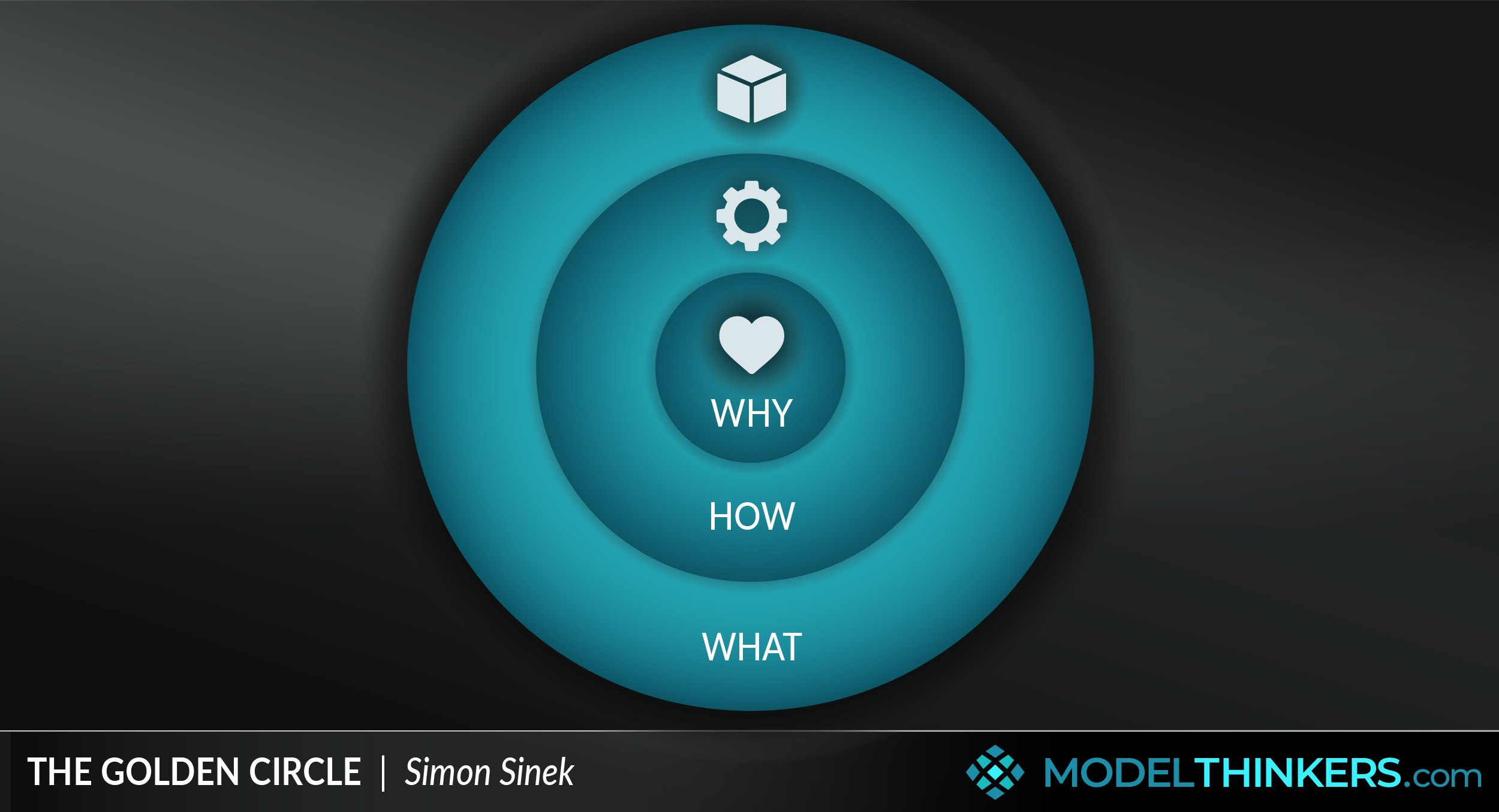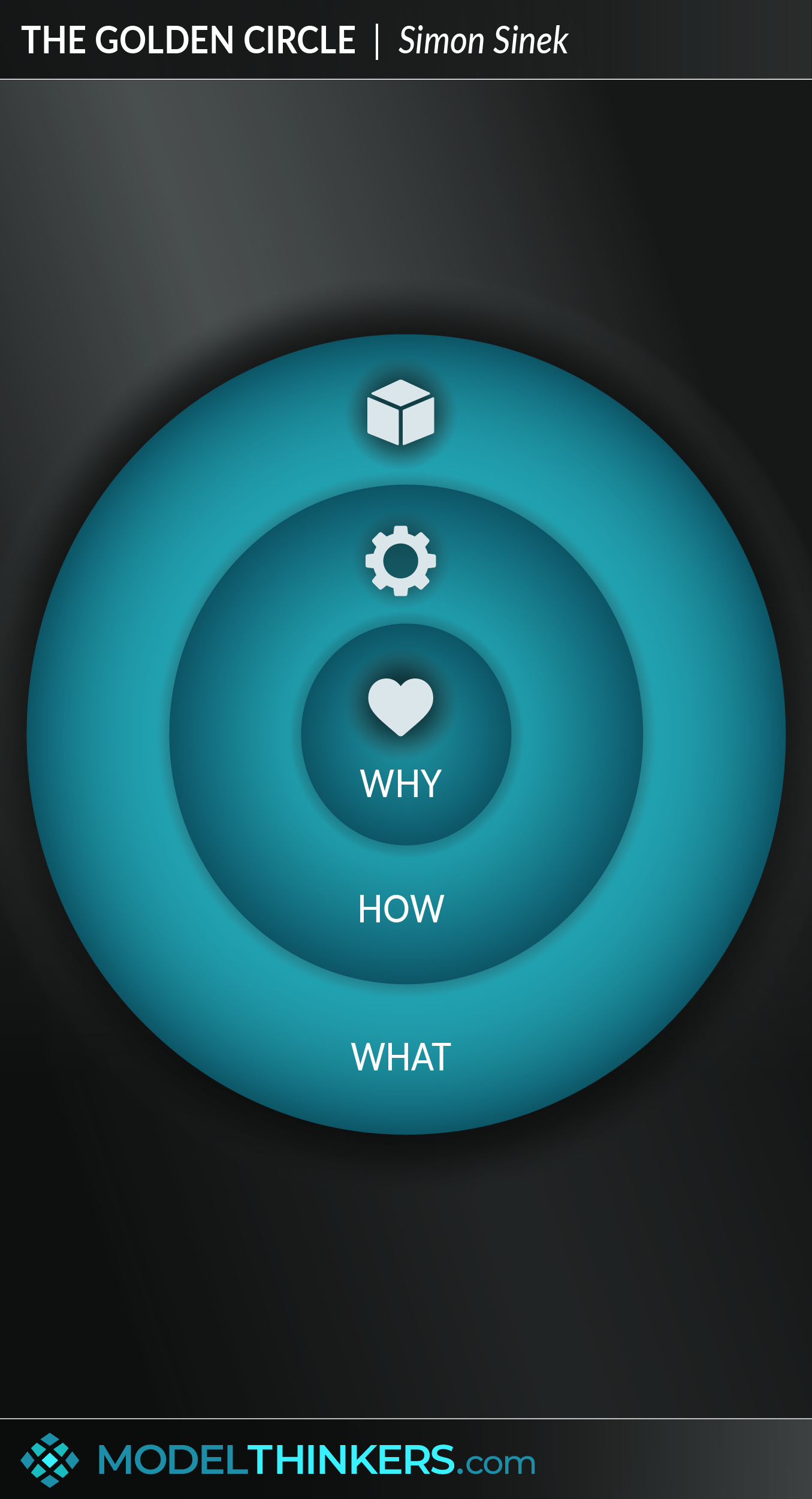

 0 saved
0 saved
 31K views
31K views








How might you act with integrity and align yourself, your work, and your business to your values?
Simon Sinek’s Golden Circle encourages you to ‘start with why’ for a purpose-driven approach to business, marketing and life
YOUR WHY.
Your why is your underlying purpose and belief. It’s the ‘soul’ of who you are, as Sinek explained: “It’s why you exist and get out of bed in the morning”. How refers to the process to achieve results and what describes the result, including the product or service you provide.
The model positions why as an emotional driver that connects with the primitive limbic brain, while how and what are more about rational thought from the neocortex. The model places why at its centre because, as Sinek explains, “people don’t buy what you do, they buy why you do it.”
LEADERSHIP & INNOVATION.
This cuts to the premise behind the Golden Circle: that successful, inspirational leaders and great companies are purpose and mission-driven. The focus on why and underlying purpose can be used to support resilience, innovation and drive emotionally-driven connections with your audience and customers.
As a result, The Golden Circle is a popular mental model in leadership and business and can be applied to developing a value proposition, in recruitment, and marketing. It can also be applied on a personal level as a self-development tool.
IN YOUR LATTICEWORK.
The Golden Circle has connections with Ikigai, in terms of uncovering purpose, and perhaps even First Principle Thinking in relation to getting back to the basics of what's important.
Finally, this model could be viewed as a form of Value Proposition, especially when applied in a customer-centric approach.




- Identify your why.
Consider what drives you and your organisation, beyond the need to make a profit. This can be surprisingly hard to do for some. Methods to identify your why include asking the following questions of yourself: What fills your cup or gets you excited? What are you consistently drawn towards during your free time? Which area of your work or life are you most tolerant of challenges and discomfort in? if you were going to die in three years, how would you like to be remembered? What comes easily to you?
- Use your why to develop resilience.
Fall back on your why during times of stress and failure. Knowing and embracing your why in these times can support you to build back and try again.
- Use your why as a foundation from which to adapt and innovate.
Rather than seeing your identity as locked into a specific product or service, or even way of working, stepping back to your why allows you to consider broader opportunities and innovate with your how and what, all while remaining true to your underlying purpose. For example, you might consider changing your processes, channels and even products as long as they still align with your why.
- Communicate your why first
As an individual or organisation, effectively communicating your why first can support you to develop meaningful, emotional relationships and better inspire others to work/engage with you.
- Express your why as part of your unique selling proposition (USP)
Express your differentiated value by communicating from the inside out and tell your audience the cause that drives you and the reason why you go to work every day. Afterwards, you can prove it with the actions your business takes and the product it provides.
The Golden Circle requires total authenticity and alignment to purpose. Expressing a purpose that you do not deliver on or act consistently around will create greater reputational damage than those actions will alone.
In a business and marketing context, it can also be challenging to engage with a cynical and sceptical audience when large multinational companies express a ‘why’ that has a disconnect with their perceived large profits and aggressive market behaviour.
Apple
Sinek’s common example for The Golden Circle is Apple. He explains that rather than describing Apple as a company that makes computers, they position themselves as a company that challenges the status quo and does things differently.
Their how is using a simple, powerful design approach that is human-centric and intuitive. That means their what, or product offer can be computers, mp3 players, watches or a range of other things that will still be aligned with their why.
The golden circle is a popular mental model in leadership and business. It can be applied to developing a value proposition, in recruitment, and marketing. It can also be applied on a personal level as a self development tool.
Use the following examples of connected and complementary models to weave the golden circle into your broader latticework of mental models. Alternatively, discover your own connections by exploring the category list above.
Connected models:
- Ikigai: the Japanese mental model that identifies your reason for being at your centre.
- First principle thinking: in terms of getting to the core of your business.
- Think fast and slow: understanding people’s quick and emotional determination of your value, which is an assumption behind this model.
Complementary models:
- Value proposition: use the golden circle to lead with your why.
- Blue ocean strategy: supports purpose driven moves into new areas.
- Inversion: consider what you do not want to stand for, or what you detest.
- Regret minimisation framework: use this decision making approach to connect with your personal ‘why’.
- Diversification: use the golden circle to drive diversity in your how and what.
- 4Ps of marketing: to develop a purpose driven marketing strategy.
- 5 whys: embracing ‘why’ as part of root cause analysis in contexts beyond company activity.
The Golden Circle mental model was created by writer Simon Sinek who, in a famous TED talk from 2009 (view a shortened version here), explained how communicating in a rational and analytical manner does not target that part of the brain which drives behaviour.
Read Start with Why: How Great Leaders Inspire Everyone to Take Action or Simon Sinek’s website for more information.
 My Notes
My Notes
Oops, That’s Members’ Only!
Fortunately, it only costs US$5/month to Join ModelThinkers and access everything so that you can rapidly discover, learn, and apply the world’s most powerful ideas.
ModelThinkers membership at a glance:






“Yeah, we hate pop ups too. But we wanted to let you know that, with ModelThinkers, we’re making it easier for you to adapt, innovate and create value. We hope you’ll join us and the growing community of ModelThinkers today.”





















































































